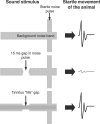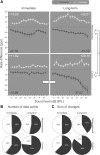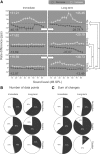Noise overexposure alters long-term somatosensory-auditory processing in the dorsal cochlear nucleus--possible basis for tinnitus-related hyperactivity?
- PMID: 22302808
- PMCID: PMC3567464
- DOI: 10.1523/JNEUROSCI.4608-11.2012
Noise overexposure alters long-term somatosensory-auditory processing in the dorsal cochlear nucleus--possible basis for tinnitus-related hyperactivity?
Abstract
The dorsal cochlear nucleus (DCN) is the first neural site of bimodal auditory-somatosensory integration. Previous studies have shown that stimulation of somatosensory pathways results in immediate suppression or enhancement of subsequent acoustically evoked discharges. In the unimpaired auditory system suppression predominates. However, damage to the auditory input pathway leads to enhancement of excitatory somatosensory inputs to the cochlear nucleus, changing their effects on DCN neurons (Shore et al., 2008; Zeng et al., 2009). Given the well described connection between the somatosensory system and tinnitus in patients we sought to determine whether plastic changes in long-lasting bimodal somatosensory-auditory processing accompany tinnitus. Here we demonstrate for the first time in vivo long-term effects of somatosensory inputs on acoustically evoked discharges of DCN neurons in guinea pigs. The effects of trigeminal nucleus stimulation are compared between normal-hearing animals and animals overexposed with narrow band noise and behaviorally tested for tinnitus. The noise exposure resulted in a temporary threshold shift in auditory brainstem responses but a persistent increase in spontaneous and sound-evoked DCN unit firing rates and increased steepness of rate-level functions. Rate increases were especially prominent in buildup units. The long-term somatosensory enhancement of sound-evoked responses was strengthened while suppressive effects diminished in noise-exposed animals, especially those that developed tinnitus. Damage to the auditory nerve is postulated to trigger compensatory long-term synaptic plasticity of somatosensory inputs that might be an important underlying mechanism for tinnitus generation.
Figures














Similar articles
-
Multi-sensory integration in brainstem and auditory cortex.Brain Res. 2012 Nov 16;1485:95-107. doi: 10.1016/j.brainres.2012.08.037. Epub 2012 Aug 24. Brain Res. 2012. PMID: 22995545 Free PMC article.
-
Noise exposure alters long-term neural firing rates and synchrony in primary auditory and rostral belt cortices following bimodal stimulation.Hear Res. 2017 Dec;356:1-15. doi: 10.1016/j.heares.2017.07.004. Epub 2017 Jul 13. Hear Res. 2017. PMID: 28724501
-
Dorsal cochlear nucleus responses to somatosensory stimulation are enhanced after noise-induced hearing loss.Eur J Neurosci. 2008 Jan;27(1):155-68. doi: 10.1111/j.1460-9568.2007.05983.x. Eur J Neurosci. 2008. PMID: 18184319 Free PMC article.
-
Cross-modal interactions of auditory and somatic inputs in the brainstem and midbrain and their imbalance in tinnitus and deafness.Am J Audiol. 2008 Dec;17(2):S193-209. doi: 10.1044/1059-0889(2008/07-0045). Am J Audiol. 2008. PMID: 19056923 Free PMC article. Review.
-
Tinnitus: Maladaptive auditory-somatosensory plasticity.Hear Res. 2016 Apr;334:20-9. doi: 10.1016/j.heares.2015.06.005. Epub 2015 Jun 12. Hear Res. 2016. PMID: 26074307 Free PMC article. Review.
Cited by
-
Temporomandibular joint disorder complaints in tinnitus: further hints for a putative tinnitus subtype.PLoS One. 2012;7(6):e38887. doi: 10.1371/journal.pone.0038887. Epub 2012 Jun 19. PLoS One. 2012. PMID: 22723902 Free PMC article.
-
Choline acetyltransferase activity in the hamster central auditory system and long-term effects of intense tone exposure.J Neurosci Res. 2013 Jul;91(7):987-96. doi: 10.1002/jnr.23227. Epub 2013 Apr 22. J Neurosci Res. 2013. PMID: 23605746 Free PMC article.
-
Detecting Noise-Induced Cochlear Synaptopathy by Auditory Brainstem Response in Tinnitus Patients With Normal Hearing Thresholds: A Meta-Analysis.Front Neurosci. 2021 Dec 20;15:778197. doi: 10.3389/fnins.2021.778197. eCollection 2021. Front Neurosci. 2021. PMID: 34987358 Free PMC article.
-
Tonotopic reorganization and spontaneous firing in inferior colliculus during both short and long recovery periods after noise overexposure.J Biomed Sci. 2013 Dec 9;20(1):91. doi: 10.1186/1423-0127-20-91. J Biomed Sci. 2013. PMID: 24320109 Free PMC article.
-
Laminar and neurochemical organization of the dorsal cochlear nucleus of the human, monkey, cat, and rodents.Anat Rec (Hoboken). 2014 Oct;297(10):1865-84. doi: 10.1002/ar.23000. Epub 2014 Aug 18. Anat Rec (Hoboken). 2014. PMID: 25132345 Free PMC article.
References
-
- Anari M, Axelsson A, Eliasson A, Magnusson L. Hypersensitivity to sound. Scand Audiol. 1999;28:219–230. - PubMed
-
- Bell CC. Duration of plastic change in a modifiable efference copy. Brain Res. 1986;369:29–36. - PubMed
-
- Bell CC. Memory-based expectations in electrosensory systems. Curr Opin Neurobiol. 2001;11:481–487. - PubMed
-
- Bell CC, Han V, Sawtell NB. Cerebellum-like structures and their implications for cerebellar function. Annu Rev Neurosci. 2008;31:1–24. - PubMed
-
- Bell C, Bodznick D, Montgomery J, Bastian J. The generation and subtraction of sensory expectations within cerebellum-like structures. Brain Behav Evol. 1997;50(Suppl 1):17–31. - PubMed
Publication types
MeSH terms
Grants and funding
LinkOut - more resources
Full Text Sources
Other Literature Sources
Medical
Miscellaneous
